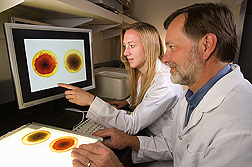|
Read the magazine story to find out more. |
|

The edible fungus Monascus purpureus, which is a regular part of the diet in southeast Asia where vitamin A deficiency is common, can be made to produce beta-carotene, potentially offering as much vitamin A as a carrot. Click the image for more information about it.
|
|

|
Red Fungus Turned Orange May Help Tackle Vitamin Deficiency
By Jan SuszkiwMay 7, 2009
The edible fungus Monascus purpureus imparts a distinct flavor and red color when added to fermented rice dishes such as those served in Asia. Now, with "a helping hand" from science, the fungus could offer a way to address a major public health concern: vitamin A deficiency (VAD).
Vitamin A deficiency is especially acute in Africa and Southeast Asia, according to Agricultural Research Service (ARS) geneticist Daniel Skinner, who is studying Monascus. In malnourished children, for example, VAD is a leading cause of preventable blindness and increases the risk of illness and death from severe infections such as diarrheal disease.
Monascus' popularity in fermented rice, noodles and other dishes—especially those eaten in poor, rural areas of Asia—gave Skinner an idea. Why not replace the fungus' pigment-producing genes with two from another species that makes beta-carotene, which the human body readily converts to vitamin A? If such a feat could be accomplished, he reasoned, perhaps a beta-carotene-producing strain of Monascus could be substituted for the one now used in Asian foods, thus offering a way to address VAD in people en masse.
In studies at the ARS Wheat Genetics, Quality, Physiology and Disease Research Unit in Pullman, Wash., Skinner and his colleagues used equipment popularly called a gene gun to fire two copies of beta-carotene genes from the fungus Blakeslea trispora into the DNA of Monascus, enabling it to make the orange-colored pigment. Cheryl Vahling, an ARS molecular biologist at Pullman, and Kamolnan Taweeyanyongkul of Mission College in Saraburi, Thailand, collaborated with Skinner.
The researchers believe the modified Monascus can produce about as much beta-carotene as a carrot, under the right growth conditions. Skinner began researching the strategy in 2002 as part of a broader program to improve wheat's productivity and quality for domestic food use and export.
Read more about this research in the May/June 2009 issue of Agricultural Research magazine.
ARS is the principal intramural scientific research agency of the U.S. Department of Agriculture.